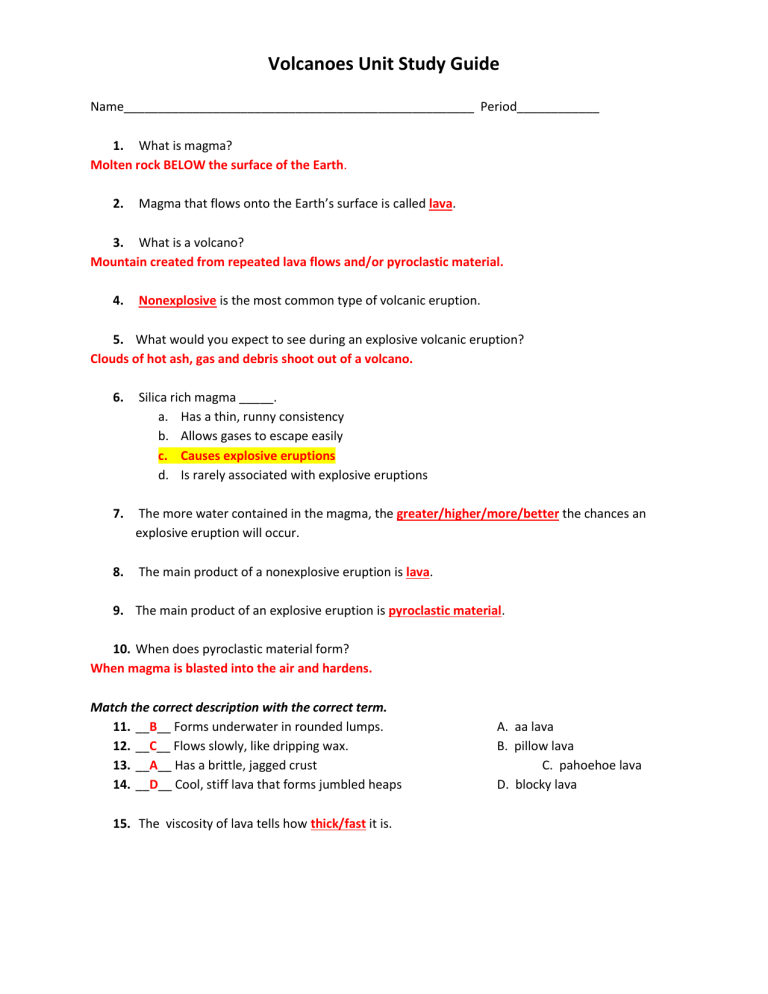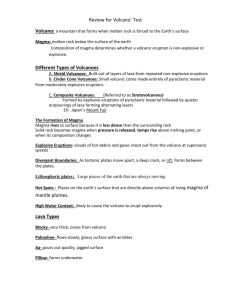Volcanoes Unit Study Guide

Volcanoes Unit Study Guide
Name___________________________________________________ Period____________
1.
What is magma?
Molten rock BELOW the surface of the Earth.
2.
Magma that flows onto the Earth’s surface is called lava .
3.
What is a volcano?
Mountain created from repeated lava flows and/or pyroclastic material.
4.
Nonexplosive is the most common type of volcanic eruption.
5.
What would you expect to see during an explosive volcanic eruption?
Clouds of hot ash, gas and debris shoot out of a volcano.
6.
Silica rich magma _____. a.
Has a thin, runny consistency b.
Allows gases to escape easily c.
Causes explosive eruptions d.
Is rarely associated with explosive eruptions
7.
The more water contained in the magma, the greater/higher/more/better the chances an explosive eruption will occur.
8.
The main product of a nonexplosive eruption is lava .
9.
The main product of an explosive eruption is pyroclastic material .
10.
When does pyroclastic material form?
When magma is blasted into the air and hardens.
Match the correct description with the correct term.
11.
__ B __ Forms underwater in rounded lumps.
12.
__ C __ Flows slowly, like dripping wax.
13.
__ A __ Has a brittle, jagged crust
14.
__ D __ Cool, stiff lava that forms jumbled heaps
15.
The viscosity of lava tells how thick/fast it is.
A. aa lava
B. pillow lava
C. pahoehoe lava
D. blocky lava
Match the correct description with the correct term.
16.
__ B __ large blobs of magma that harden in the air
17.
__ A __ solid rock blasted out of a volcano
18.
__ D __ glass-like slivers from the walls of exploding gas bubbles
19.
__ C __ pebblelike bits of magma that cool in the air
22.
__ A __ forms from lava, not steep
23.
__ B __ often occurs in clusters
24.
__ C __ forms from alternating layers of pyroclastic material & lava
25.
__ B __ made entirely of pyroclastic material
26.
__ C __ sometimes called a stratovolcano
A. volcanic blocks
B. volcanic bombs
C. lapilli
D. volcanic ash
20.
What is a pyroclastic flow?
Enormous amounts of hot ash, debris and gas are ejected from a volcano and flow down the volcano.
Match the description with the correct volcano type.
21.
__ A __ the largest mountain on Earth. A. shield volcano
B. cinder cone volcano
C. composite volcano
27.
A funnel shaped pit around a volcano’s central vent is called a(n) crater .
28.
When the roof over a magma chamber collapses, it forms a caldera .
29.
Craters, calderas and lava plateaus are volcanic landforms .
30.
A long crack in the Earth’s crust is called a(n) fissure (rift) .
31.
After repeated eruptions of lava spread over a large area, lava plateas are formed.
32.
Lava plateaus are created by repeated eruptions.
33.
Describe the rock of the Earth’s mantle.
Solid rock that is under intense heat and pressure that causes it to act like a liquid. (Pliable rock that acts like Play-Doh.)
34.
Magma forms in the deeper regions of the Earth’s crust and the uppermost layers of the mantle .
35.
Changes in heat (temperature) and pressure cause magma to form.
36.
How does magma behave like air bubbles in a jar of honey?
Rise very slowly.
37.
About 80% of active volcanoes form on land where plates collide .
38.
Why are the plate boundaries surrounding the Pacific Ocean called the Ring of Fire?
Because there are so many volcanoes in the area around the Pacific Plate
39.
A set of rifts between separating plates is called a(n) mid-ocean ridge (rift valley) .
40.
What are hot spots? What island chain is being created by one?
Volcanically active spot on the Earth’s surface where magma rises that is NOT near a plate boundary.
Hawaiian islands are forming this way.
Match the description with the correct term.
41.
__ C __ have not erupted in thousands of years
42.
__ B __ have not erupted recently
43.
__ A __ are erupting not
44.
__ C __ probably won’t ever erupt again
45.
__ B __ will probably erupt sometime in the future
46.
__ A __ will probably erupt in the near future
A. active volcano
B. dormant volcano
C. extinct volcano
47.
What are some indications that a volcano will erupt soon?
*Small earthquakes *Change in slope
*Release of gases *Temperature increase
48.
What are 3 ways scientists predict volcanic explosions?
*GPS
*Satellite images
*Tiltmeter
49.
What might cause a bulge in the slope of a volcano?
Rising magma in the volcano.
50.
Why don’t WE experience a volcanic threat in our area?
We aren’t near a tectonic boundary or a hot spot.
Fill in the chart below correctly.
Type of volcano: What they are
Shield volcano Lava composed of:
Composite volcano
Cinder cone volcano
Lava
Pyroclastic material
Pyroclastic material
What type of lava
Runny
NONE produced:
Mainly runny
Some may be blocky
Explosive or nonexplosive?
Nonexplosive
Both
Explosive







